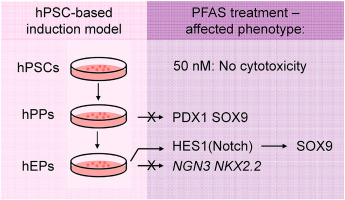当前位置:
X-MOL 学术
›
Chemosphere
›
论文详情
Our official English website, www.x-mol.net, welcomes your feedback! (Note: you will need to create a separate account there.)
Effects of per- and poly-fluorinated alkyl substances on pancreatic and endocrine differentiation of human pluripotent stem cells.
Chemosphere ( IF 8.8 ) Pub Date : 2020-04-06 , DOI: 10.1016/j.chemosphere.2020.126709 Shuyu Liu 1 , Renjun Yang 2 , Nuoya Yin 2 , Francesco Faiola 2
Chemosphere ( IF 8.8 ) Pub Date : 2020-04-06 , DOI: 10.1016/j.chemosphere.2020.126709 Shuyu Liu 1 , Renjun Yang 2 , Nuoya Yin 2 , Francesco Faiola 2
Affiliation

|
Perfluorooctanoic acid (PFOA) and perfluorooctanesulfonic acid (PFOS) are typical per- and poly-fluorinated alkyl substances (PFASs) that epidemiological studies have already associated with diabetes. However, insufficient data on their toxicity have been reported to explain any mechanism of action, which could justify such an association. Meanwhile, short-chain PFASs designed to substitute PFOA and PFOS, have already raised increasing concerns for their biosafety. Here, we evaluated whether common PFASs affected pancreatic and endocrine cell development using a human pluripotent stem cell pancreatic induction model and human pancreatic progenitor cell (hPP) endocrine induction model. The short-chain PFASs, pentafluorobenzoic acid, perfluorohexanoic acid, perfluorobutanesulfonic acid, and perfluorohexanesulfonic acid, homologous to PFOA or PFOS, did not significantly disrupt hPP generation, unlike PFOA and PFOS, based on pancreatic and duodenal homeobox 1 (PDX1) expression. However, SRY box 9 (SOX9) expression was suppressed in PDX1+ hPPs. All six PFASs did not disrupt SOX9 expression or hPP proliferation. However, endocrine differentiation of hPPs was affected, as indicated by neurogenin-3 (NGN3) downregulation, owing to abnormal increases in SOX9 and hairy and enhancer of split-1 (HES1) expressions. Thus, hyperactivation of NOTCH signaling was repressed after hPPs committed to the endocrine lineage. In conclusion, our study demonstrates how powerful human pluripotent stem cell-based pancreatic differentiation models can be in developmental toxicity evaluations, compared to traditional toxicity assays, mostly based on live animals. Moreover, our findings suggest that PFASs may alter pancreatic development after the pancreatic domain emerges from the gut tube, and provide insights into their toxicity mechanisms.
中文翻译:

全氟和多氟烷基物质对人多能干细胞胰腺和内分泌分化的影响。
全氟辛酸(PFOA)和全氟辛烷磺酸(PFOS)是流行病学研究已经与糖尿病相关的典型的全氟和多氟烷基物质(PFAS)。然而,关于其毒性的数据尚不足以解释任何作用机理,这可能证明这种关联是合理的。同时,旨在替代全氟辛烷磺酸和全氟辛烷磺酸的短链全氟辛烷磺酸已经引起人们对其生物安全的日益关注。在这里,我们使用人类多能干细胞胰腺诱导模型和人类胰腺祖细胞(hPP)内分泌诱导模型评估了常见的PFAS是否影响胰腺和内分泌细胞的发育。与PFOA或PFOS同源的短链PFAS,五氟苯甲酸,全氟己酸,全氟丁烷磺酸和全氟己烷磺酸,与PFOA和PFOS不同,基于胰腺和十二指肠同源盒1(PDX1)的表达,hPP的产生没有显着干扰。但是,PDX1 + hPPs中SRY box 9(SOX9)的表达受到抑制。所有六个PFAS均未破坏SOX9表达或hPP增殖。但是,由于神经生成素3(NGN3)下调,hPPs的内分泌分化受到影响,这是由于SOX9异常增加以及split-1(HES1)表达的毛发和增强剂所致。因此,在致力于内分泌谱系的hPP后,NOTCH信号的过度激活被抑制。总之,我们的研究表明,与传统的基于动物的毒性试验(主要基于动物)相比,基于人类多能干细胞的胰腺分化模型在发育毒性评估中的功能强大。此外,
更新日期:2020-04-06
中文翻译:

全氟和多氟烷基物质对人多能干细胞胰腺和内分泌分化的影响。
全氟辛酸(PFOA)和全氟辛烷磺酸(PFOS)是流行病学研究已经与糖尿病相关的典型的全氟和多氟烷基物质(PFAS)。然而,关于其毒性的数据尚不足以解释任何作用机理,这可能证明这种关联是合理的。同时,旨在替代全氟辛烷磺酸和全氟辛烷磺酸的短链全氟辛烷磺酸已经引起人们对其生物安全的日益关注。在这里,我们使用人类多能干细胞胰腺诱导模型和人类胰腺祖细胞(hPP)内分泌诱导模型评估了常见的PFAS是否影响胰腺和内分泌细胞的发育。与PFOA或PFOS同源的短链PFAS,五氟苯甲酸,全氟己酸,全氟丁烷磺酸和全氟己烷磺酸,与PFOA和PFOS不同,基于胰腺和十二指肠同源盒1(PDX1)的表达,hPP的产生没有显着干扰。但是,PDX1 + hPPs中SRY box 9(SOX9)的表达受到抑制。所有六个PFAS均未破坏SOX9表达或hPP增殖。但是,由于神经生成素3(NGN3)下调,hPPs的内分泌分化受到影响,这是由于SOX9异常增加以及split-1(HES1)表达的毛发和增强剂所致。因此,在致力于内分泌谱系的hPP后,NOTCH信号的过度激活被抑制。总之,我们的研究表明,与传统的基于动物的毒性试验(主要基于动物)相比,基于人类多能干细胞的胰腺分化模型在发育毒性评估中的功能强大。此外,


























 京公网安备 11010802027423号
京公网安备 11010802027423号